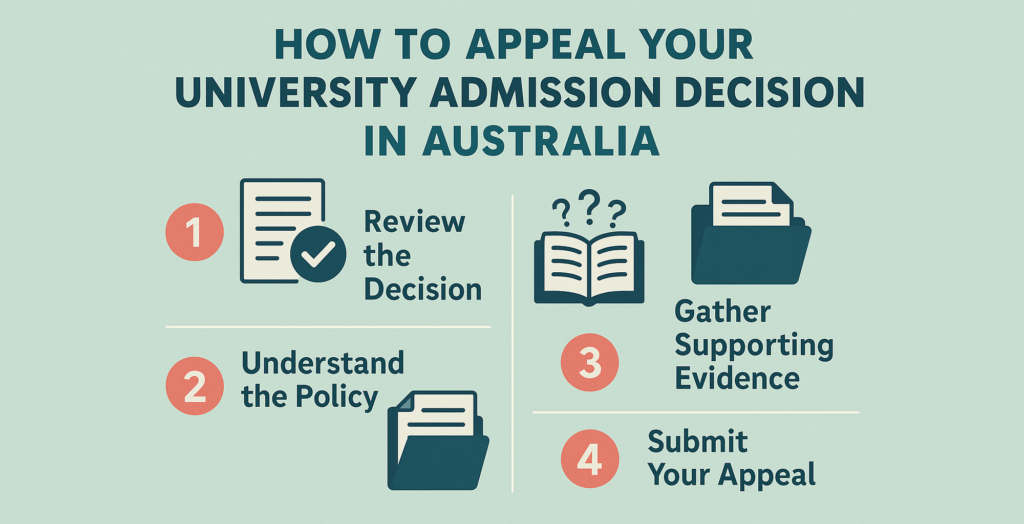How to Appeal Your University Admission Decision in Australia
Receiving a university rejection letter can be upsetting, especially if you had your heart set on a specific course or university in Australia. But in some cases, you might be able to appeal the decision.
An appeal isn’t just about asking the university to “give you another chance.” It’s a formal process that allows you to request a review if something went wrong during the admission process, or if you have new, relevant information that could change the outcome.
This guide explains how admission appeals work in Australia, when you should consider submitting one, and how to approach the process step by step.

What Is a University Admission Appeal?
A university admission appeal is a written request asking the university to reconsider its decision. This usually only applies if:
-
There was an error in processing your application, or
-
You have new or updated evidence that could support your case.
It’s not available at every university or in every situation. So before anything else, you’ll need to check if the university allows admission appeals, and under what conditions.
When Can You Appeal?
You should only appeal if you have a clear and valid reason. Here are some examples:
-
Your final exam results improved after you applied, and your new ATAR (or equivalent) now meets the entry requirement.
-
There was a clerical or administrative error, like your scores were entered incorrectly, or a document went missing even though you submitted it.
-
You faced serious personal circumstances, such as illness or family issues, affecting your application. And now you can provide official documentation to explain what happened.
It’s not a good idea to appeal just because you’re disappointed. Most universities won’t change their decision based only on how much you want to study there.
Step-by-Step: How to Appeal Your Admission Decision
1. Check the University’s Appeal Policy
Start by visiting the university’s official website and looking for its admission appeal process. You’ll usually find it under sections like “Admissions,” “Student Policies,” or “Grievances and Complaints.”
Each university has different guidelines. Pay close attention to:
-
Deadlines (some may be as short as 10 working days)
-
How to submit the appeal (online, by email, or by post)
-
Required documents
If you miss a deadline or leave out documents, your appeal might not even be reviewed.
2. Know What You’re Appealing
Most universities in Australia don’t allow appeals just because your marks were a bit below the cutoff. You’ll need to show that either:
-
There was a mistake, or
-
Something important changed after you applied.
Before you start writing anything, be sure your reason fits their policy. If you’re unsure, you can email the university’s admissions office for clarification.
3. Collect Supporting Documents
Strong evidence makes a stronger appeal. Depending on your situation, this could include:
-
Updated academic results
-
A letter from your school or teacher
-
Medical certificates or psychologist reports
-
Proof of special circumstances, like family emergencies or financial hardship
Make sure your documents are clearly labelled, dated, and relevant.
4. Write Your Appeal Letter
The appeal letter is your chance to explain what happened and why your application should be reconsidered. Keep it brief—usually one page is enough—and focus on facts, not feelings.
What to include:
-
Your full name, student ID (if available), and the course you applied for
-
A clear explanation of what changed or went wrong
-
A polite request for the university to review your application
-
A list of attached documents or evidence
Example:
Dear Admissions Team,
My name is Ravi Sharma, and I applied for the Bachelor of Science program at ABC University for Semester 1, 2026. I’m writing to request a review of my admission decision dated 10 June 2025.
Since submitting my application, I received updated Year 12 results, with an ATAR of 89.60—above the required minimum of 88. I’ve attached my final results as issued by the VCAA.
I respectfully request a reconsideration of my application based on this updated information. Thank you for your time.
Kind regards,
Ravi Sharma
5. Submit the Appeal
Once your letter and documents are ready, follow the university’s instructions to submit your appeal. Keep a copy of everything, and if you don’t receive a confirmation, contact the admissions office to check that it was received.
6. Wait for a Response
Most universities will get back to you within a few weeks. Some may ask for extra information, so check your email regularly. While waiting, consider other options too, like accepting an offer at another university or preparing for a pathway course.
If Your Appeal Is Not Successful
It’s disappointing when an appeal doesn’t go your way, but it’s not the end of the road. You still have a few options:
-
Apply for a related course: Some courses have lower entry requirements but can lead to the same career path.
-
Enrol in a pathway program: TAFE or university foundation programs can help you meet entry standards for next year.
-
Reapply later: Use the time to build your qualifications or gain work experience.
-
Consider other universities: There are many great institutions across Australia.
Final Tips
-
Be respectful and honest: Keep your letter professional. Avoid blaming the university or being emotional.
-
Stick to the facts: Only include information that’s directly related to your appeal.
-
Use simple language: Your message should be easy to read and understand.
-
Proofread before submitting: Spelling and grammar matter.
Need Help Writing Your Appeal?
Writing a clear, convincing appeal letter can be difficult, especially when you’re stressed about the outcome. If you want expert help putting your thoughts into words or reviewing your documents before submission, we’re here to support you.



